Abstract
Learning is an endless process that is marked by changes in behavior, attitude, perception, knowledge, and understanding of various aspects of life. Even though the bulk of learning activities is on students’ backs, parents, teachers, and society play significant roles in facilitating effective learning and better performance. This paper analyzes the impacts of parents’ participation on their achievement. This participation is in the form of social, economic, and psychological needs provided to students by their parents while at home or school. Chapter 4 is an analysis of the study as presented through both qualitative and quantitative data obtained from previous research conducted by academic experts. Chapter 5 presents the introduction, implications of findings, the scope of the study, and recommendations.
The Effects of Parent Involvement on Student Achievement
Summary of Findings as Indicated in Chapter 4
Training involving teacher-parent associations involve teachers heartening parents to take an energetic role in their children’s education. Nonetheless, the teachers in the Title I public school failed to provide parents the ways an active involvement can be attained without interfering with other activities.
An evaluation of the demographic data from the parental educational attainment shows that a small fraction had attained higher training. This means they lack adequate knowledge and experience regarding education and thus cannot help their students cope with learning challenges (Markow 2009). This is suggestive of the need for a teacher-parent guidance tool to help parents to identify teaching approaches that will help their children to improve their grades.
The population of the participants used within this assessment consisted of 3rd 4th and 5th grade students in a school of 534 pupils. Students were randomly sampled based on their skin color. The table below presents the demographics of the pupils whose results were received.
Interpretation of findings
Parental involvement
An assessment of the data from the study exposes a variety of unusual results that were not initially anticipated by the examiner. One of the research results showed that parents recognize that parental participation in a child’s learning is significant and leads to improved grades. Few parents asked their children about their performance in school as can be seen in the following table. The second table shows the parents who visited their children at school.
Linking Parental Involvement with School Activities
A study on parental participation practices offers the idea that the limited parental involvement in their child’s educational achievement was related to weak links between practice and policies that various learning institutions neglect to keep in mind. The research showed that most teachers were not offered key positions in making school decisions. They all decided that most parents have no idea about how to help students to study at home. The results showed that, even if parents were eager to help their children in their education activities, the teachers pointed out that the parents did not know how to assist their children. There is no doubt that most parents were willing to attend school activities as a way of providing social support to students (Sekaran 2010). These activities are usually meant to bond teachers, students and parents. However, it is apparent that these activities exist to ensure school calendars are observed and do not have any impacts on students performance (Abernathy 2009).
Data Analysis According to Research Questions
Question 1: What are the Differences in Student Achievement among Students in Grades 3, 4, and 5 at The Elementary School under Study?
It was imperative to identify salient aspects that help parents in assisting their students during holidays or in the evenings. The results presented show that BA outcomes obtained during the research comprised the achievements of Grade 3, 4, and 5 learners in developing their talents and skills in the use of English language as far as textual research, vocabulary use and literature analysis is concerned. The following tables show the results obtained from the research regarding the performance of grade 3, 4 and 5 students.
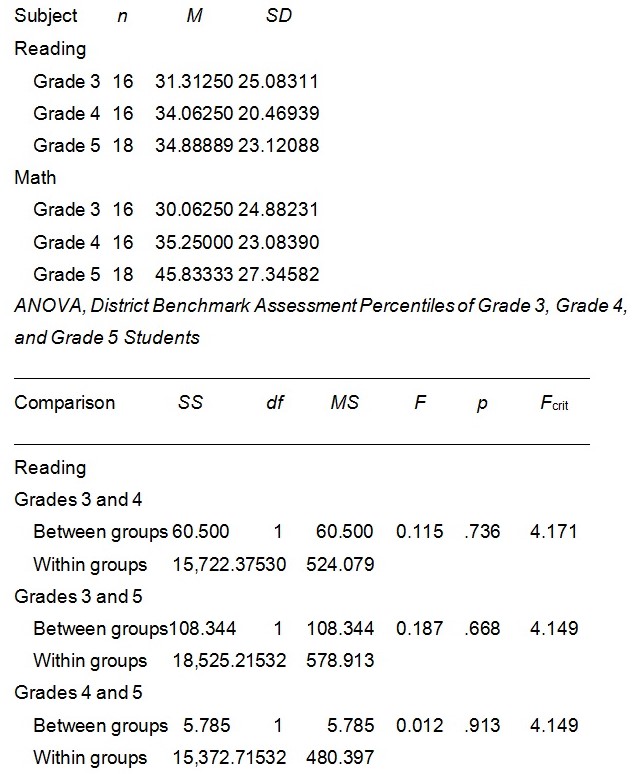
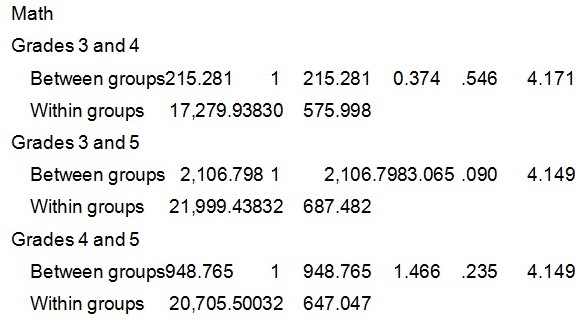
According to the results above the grade 5 students had top overall grades than those of others in the 3rd and 4th grades. This proves a disparity in the levels of academic accomplishment in relation to language development skills in all students in the grades studied. The students in this grade had better methods of learning English and sciences compared to other students. It is necessary to note that learning is not just a matter of listening, reading and copying notes from the blackboard. Teachers must develop teaching strategies that will ensure students are able to identify basic principles that guide different studies (Sekaran 2010).
In addition, the results obtained during the research encompass the success of grade 3, 4, and 5 students in arithmetic and English. It contains their overall success in tabulation, geometry, dimension, rations and fractions. On the other hand, in its place of fifth-grade students to be ranked close to the top the students from the 3rd grade are the ones that have these high overall scores, pursued closely by those students in the 4th grade. Additionally, it can be concluded that the outcomes from the BA data answered the first research question effectively by presenting that there is without a doubt a degree of disparity in student attainment among those in the 3rd, 4th, and 5th at the school under study. The above explanations are represented in the table below.
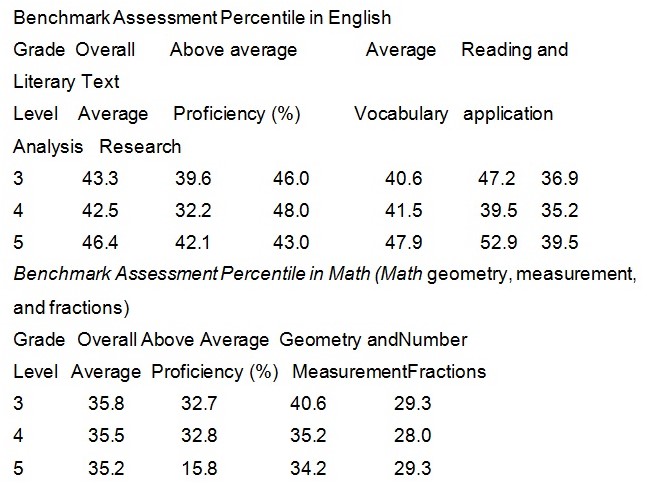
Question 2: To What Extent are the Differences in Student Achievement in Grades 3, 4, and 5 Correlated with Parent-Involvement Indicators of Parenting Practices?
The answer to this question was obtained by the researcher by combining the BA study outcomes along with a t-test and an ANOVA assessment of the parental answers to effectively answer the research question without confusions.
From the ANOVA assessment the results were used to compare the level of parental participation when it came to learners’ reading and writing skills and its consequent impact on their performance. The t-test test carried out was done to study whether there was an essential dissimilarity in parental contact and if so how it is evident in student academic outcomes. In the joint ANOVA, it is evident that the F-ratio linking 4th and 5th grade students showed achievements of 15.510 and 8.422. In addition, there was an evident statistical significant difference between them of about o% as is expressed in the formula p =.00 that links the parent’s participation scores of the 4th and 5th grade students who participated in the study.
A significance ratio of.000 and an F-ratio score of 25.077 were very evident in vocabulary and spelling analysis. In addition, there was a statistically major difference of p =.00 when the significance determinant was set at 0.50 between the level of parental participation of 5th grade students and the level of parental participation of students in the 3rd grade. Similar results can be noticed in individual ANOVA of 3rd, 4th, and 5th grade students all these indicated a significance difference in their outcomes. A t test was carried out to determine the significance of the differences in these results.
The results obtained from this t test showed that there is a substantial statistical disparity between the results as indicated by the combined data analysis. In addition, it was evident that those from Grades 3 and 5 had a high level of parental participation as compared to those from Grade 4. Therefore, this test proves that there is the possibility of noticing significantly high rates of excellent performance. Consequently, it is easy predict that students from 3rd and 5th grades would have comparable results with the likelihood of students from 5th grade having somewhat higher grades because of the greater degree and consistency of parental influence.
Spelling, Vocabulary and reading
Parents of Grade 3 pupils infrequently read with their children and assisted them to know and learn vocabulary. From the results obtained it was clear that 88% and 45% (respectively) of students passed their examinations. Most parents (77%) of 4th grade students placed a low importance on assisting their children with comprehending, reading and interpreting language assignments with their spelling, comprehension and vocabulary classes having reached more than 50%. This was evident itself in grade 4 students having a high average vocabulary grade. Therefore, this demonstrates a major impact on student accomplishment based on consistent and regular parental participation in the learning process. Furthermore, in the case of 5th grade students it was observed that the parents hardly read with their children. On the other hand, parents of 5th grade students regularly went over vocabulary reading and spelling exercises with their children.
Dissimilarities are evident between the results of the two grade groups with a high percentage of the above standard proficiency, normal capability, fictional analysis, and information wording research being accredited to 5th grade students. The 4th grade students’ high performance in their reading and vocabulary scores and their application, which were forecasted by the research due to the high level of parental accomplishment in these areas are nonetheless not much higher compared to previous results (Abernathy 2009).
The t-test and ANOVA outcomes pointed out that the parents of 3rd and 5th students contributed more in their child’s reading and vocabulary lessons at home and, as pointed out by the tests outcomes, this manifested a considerable level of performance dissimilarity. The above scores (t-test and ANOVA) proved a high level of parental participation in the research of their children as contrasted to 3rd and 4th grade students.
Math Test Scores
The t-test and ANOVA assessment results in the case of parental contribution in math show an enormous deal of resemblance with the scores in interpretation and vocabulary as is evident in the results above. For instance, the examination concerning 3rd and 5th grade students had an F-ratio of 78:148. On the other hand, the consequence ratio was almost 0:0. Therefore, these results are problem-solving of a statistically major difference between the above achievements and demonstrate that the level of parental relations is definitely dissimilar. Similar inferences and observations can be seen in the assessment between 3rd and 4th grade students where the F and significance ratios were 15.670 and 0:0 respectively. Last but not least, the results of 4th and 5th grade students were studied showing significance ratio of.009 and an F-ratio of 6.864. Despite the fact that the significance ratio between these two is close to 0.50 it is nonetheless far lower than the essential score to show an important statistical resemblance as shown by the results above. Moreover, the statistics recounting parents’ reported participation in the teaching of math are similar to the results above.
While understanding the scores of the ANOVA and t test it is necessary to state that the following relationship was noted: First, 88% of the parents of 3rd grade students took an energetic participation in their children’s lessons involved arithmetic and vocabularies. Out of the whole population it is evident that 63% of parents had actively participated in the case of 4th grade students while the parents of 5th grade students spent most of their time helping their students in mathematics. This accounted for almost 72% of their time.
The final result shows that the difference between 3rd and 4th grade students was evident in the 3rd grade students having a slightly high standard achievement; moreover, these results were also evident a high above normal proficiency and a radically high score in geometry, measurement and a higher score in number-fractions. It can be concluded that this is further evidence that when parents take an active role in their child’s education it nonetheless manifests itself in improved academic achievement. Therefore, it must be noted however that in the case of 3rd and 4th grade students their parents neglected their children in providing adequate assistance in helping learners prepare for mathematics assessment and in isolation shows how parental carelessness also works since the scores are still significantly lower than the general average.
An assessment of 5th grade students proves that they are unusually helped by their parents in the evenings or holidays in terms of school work. However, when it was through it showed itself in definitely high percentages. Comparable to the case seen in the preceding two examples the high percentage of parents assisting their children when it came to arithmetic translated into high test scores with the students in the 3rd grade coming out on top since most parents (88%) of those students assisted as contrasted to the 4th grade students (66%) and 78% for 5th students.
A comparable case patented itself in regard to vocabulary and language in which the larger percentage of parents coaching their children vocabulary and reading in 5th grade students transformed into high academic results for the 5th grade students when it came to vocabulary and reading. This was in fact predicted by the ANOVA and t test in which it was exposed that 3rd grade students got considerably more parental concentration in mathematics as contrasted with the other two groups (4th and 5th grade students). Despite the fact that it may be accurate that the percentile disparities are rather low, there is tangible proof showing that instances of recurrent parental participation in teaching a child indeed do have an explicit impact on students’ achievement.
Testing Results (FCAT)
The parental involvement indicators were measured by observing homework assistance, parent-teacher conference, school-event attendance, and volunteerism.
The following is an assessment of the FCAT information provided by the school about the performance heights of the Type 1 School when contrasted with the national standard via the FCAT testing process. It is clear that the population of this meticulous examination consist of the parental survey statistics used in the former examination.
Analysis
The research results of the FCAT were contrasted with the reactions of the parents regarding their participation in specific subjects for instance science, math and English. An assessment of the FCAT figures with the parental review results revealed a separate association between the rate of parental participation in certain subjects and how this influences the capability of children to really perform rationally in their education. The results show the results of those who took the FCAT (Florida Comprehensive Test Assessment).
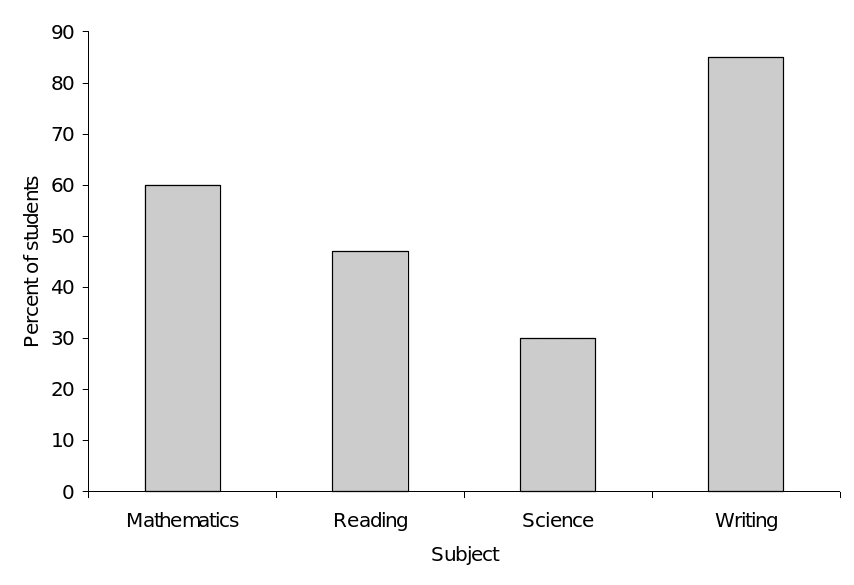
As seen in the Florida Comprehensive Test Assessment examination above that measured the percentage of students in the 3rd -5th grades that were able to meet FCAT level three and above, those within the Type 1 elementary school attained high grades in writing and mathematics as contrasted to those who took up languages and science.
Parental Action
The parents of 3rd -5th grade students paid an extreme greater interest to teaching their children science, math, vocabulary and spelling as pointed out by their rate of participation. While investigative their level of participation in science it can be observed that they hardly ever actively took part in their child’s science study.
While evaluating the survey results of the parents with the Florida Comprehensive Test Assessment data it can obviously be seen that there is a separate association between parental participations in particular subjects with the principally level of accomplishment students are able to attain (Saunders 2011). This can be seen as added evidence in support of the supposition of this study since the results were obtained from the total of the population of 3rd and 5th grade students.
Parental Inquiry
The results give the details and the frequency by which parents assist their children appreciate the lessons they have learnt in school, it made possible the researcher to decide how regular parents cooperated with their children and how it influenced the student’s scores on these lessons.
Parental Support
while taking into thought differing percentages of parental participation in specific subjects in the 3rd, 4th and 5th grades and resultant difference in results, it demonstrates that the first assumptions of this paper were precise in assuming that parental performances at home in the shape of greater parental participation in a child’s learning course absolutely has an impact on the way in what they attain academically.
Parental participation in English and mathematics showed a high degree of student attainment in some grades as evaluated against students who had low parental participation in similar subject. In addition, the outcomes of the study also proved that students who had better degrees of parental participation in mathematics had radically high scores as contrasted with those who did not have a comparable level of participation as shown in this table.
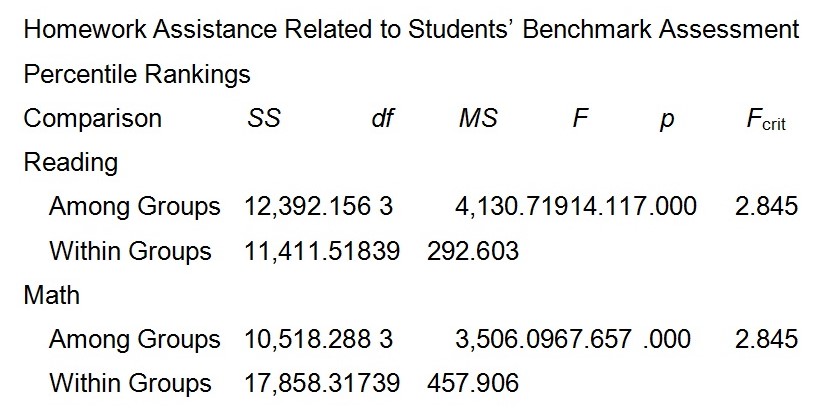
Teacher-Parent Interactions
Nine teachers were used in the first experiment to collect data regarding students’ performance in schools. This was an effective way of collecting first hand information from the source. The data was more accurate and reliable compared to other sources even though there were probabilities that teachers may provide biased understanding of the real situations.
The research used four groups as described by Epstein’s Typologies (those that strongly agree, agree, disagree and strongly disagree) to assess parental participation in learning. Most teachers opposed this statement “Parents of children at this school want to be involved more than they are now at most grade level”. The data below shows how teachers perceived parental participation in learning and their reactions towards it.
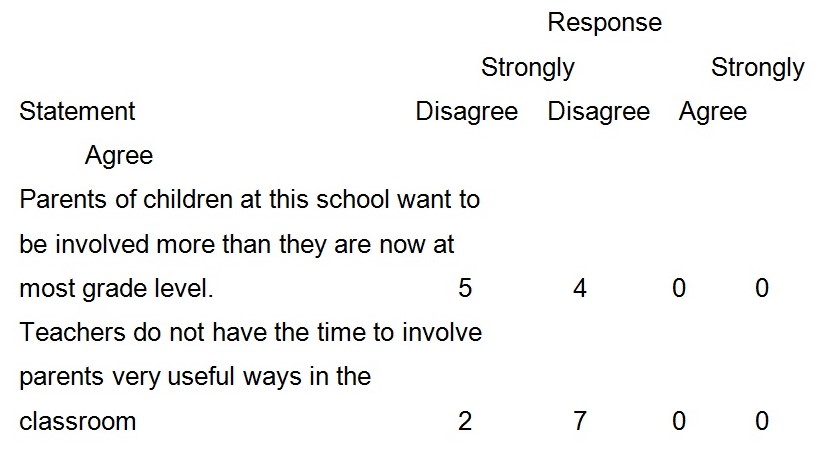
Alternatively, parents of Title I school students refused to participate more than they did then. Majority of these parents assumed that teachers were capable of making their students pass without parental involvement. The table below gives an overview of the results obtained regarding teacher-parent relations.
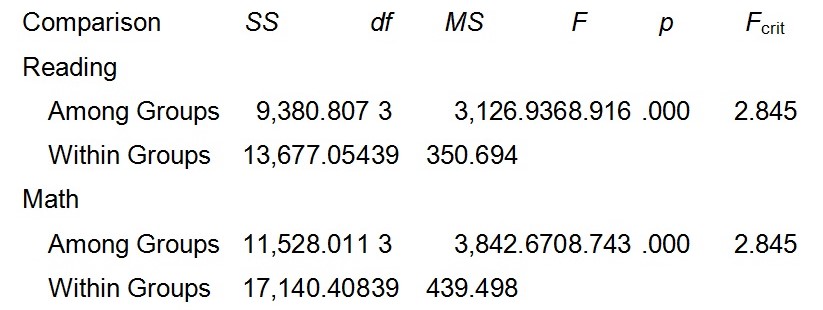
Volunteerism
The self-reported standards at which parents worried themselves with learning had significant results. Shockingly, some parents were convinced that by doing their children’s assignments they were helping them to pass their final examinations (Saunders 2011). This indicates that lack of adequate programs by parents in helping their children to study should be a driving force towards strengthening teacher-parent relationships. There are other issues involving ethnic and social qualities that limit parental participation in learning.
Furthermore, it was evident that most parents were concerned about other issues like jobs and thus did not have enough time to teach their children. The table below gives an overview of parental volunteerism to teach their children.
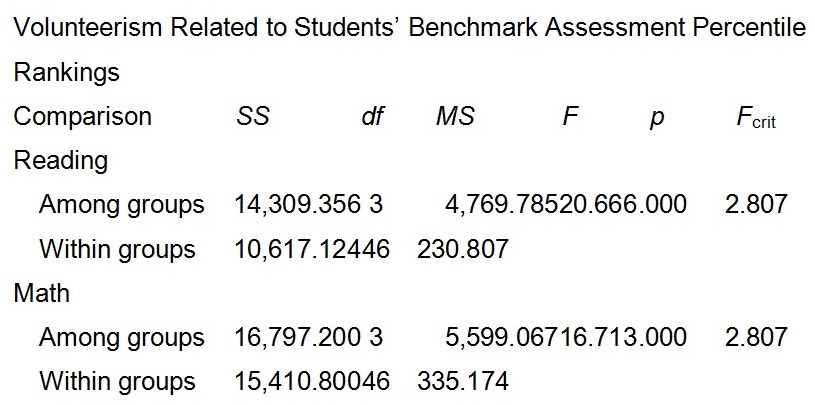
It is clear that when assessing the demographic data from the study linking the educational attainment of the parents, it was exposed that an immense percentage of those concerned in the study had a low level of high school education. Additionally, the data showed that 32% of the parents dropped out of high school, 34% completed, and 21% had attained formal education beyond secondary schools. The tables below analyze the impacts of parents’ level of education on students’ performance at school.
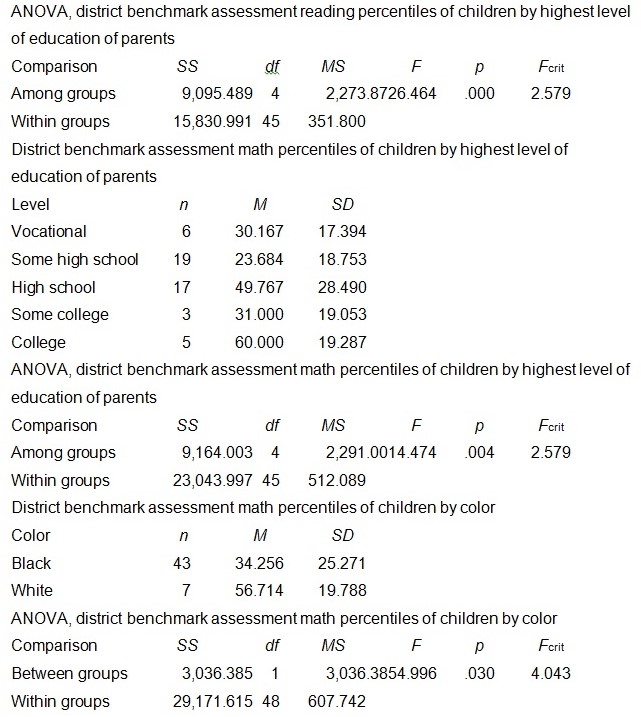
When taking these results into consideration it can be thought that these parents are short of a enough level of higher education to adequately communicate the required information and expand the essential lesson plans in their children. Parents who participated in the research claimed to talk frequently to teachers to find out how their children perform.
Regardless of the fact that practices linking teacher-parent relations involves teachers encouraging parents to adopt dynamic approaches while educating their children. The irony of this is that teachers did not advise parents on any effective home-based teaching strategy. The results can be seen in the table below.
Question 3: To What Extent Do Epstein’s Six Typologies (As Cited In Epstein & Salinas, 1993) Offer a Conceptual Framework for Explaining Parent Involvement in the School under Study?
Epstein’s six typologies include volunteering, decision making, learning at home, communicating, volunteering, learning at home, parenting, and collaborating with community. These typologies allowed the investigator to decide the methods parents used towards facilitating the techniques used by teachers in supporting in learning. The graph below gives a prompt into this inquiry.
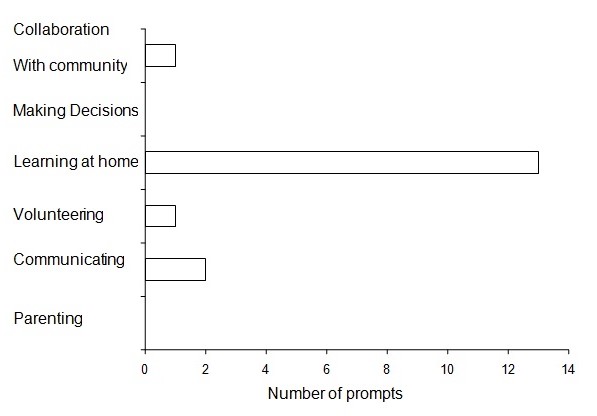
In addition, it was inestimable in determining the inherent flaws in the process and what likely technique could be adopted in this evaluation. In spite of the use of these typologies to facilitate data collection it was unable to garner a overwhelming perspective about parents’ views on likely procedures that would participate their contributions to learning.
The research established that 88% of third grade students’ parents participated actively in teaching their students. In contrast, less than 63% of grade four students’ parents were interested in helping their students learn various subjects. The grade five student’s parents were dominant in helping students solve sand study mathematics and science topics. It was established that schools are working hard to ensure parents participate in their children’s learning (Bandura 2011). It was evident that most parents took a back stage when it came to students’ learning this means that the little effort they gave their children id not have any impacts in their performance.
The communication typology used established that 90% of teachers agreed that there was poor communication between parents and students regarding how the later should be assisted while studying at home. This contributed to non participation by parents and consequently lowered students’ grades. In addition, volunteerism was also a significantly absent aspect in learning. Lack of enthusiasm, skills and time are the most likely causes of this trouble. Even though, most parents attended most school events this did not have a direct impact on performance. There was no way parents would teach students at home if they did not have adequate skills ad knowledge to do so. The results revealed that parents lacked adequate curriculum guiding activities to teach their children during weekends, holidays and evenings (Zelman 2008). Most of their instructions were based on general knowledge and not the curriculum used at school. There was the need to incorporate two typologies were included into the preceding typologies and had comparatively slight influence on the study outcomes.
Question 4: To What Extent Does Parent Involvement Influence a Student’s Academic Achievement?
The study outcomes decisively demonstrate that an advanced degree of parental participation has a significant impact on students’ performance. The tables below show the significance of parental participation in their children’s learning regarding their learning experiences and contributions to students’ performance.

It is necessary for parents to be involved in the equation concerning student learning results since they frequently act as the main educators more than their teachers (Harold 2008). When investigating the participants it was observed that, while there was a definite degree of parental participation in learning the proportion in which this took place was comparatively low and had limited impacts.
Elaboration and Interpretation of Results as Related to Research Questions
The results obtained from this study indicate various degrees of performance after parental involvement in learning. The 3rd, 4th and 5th grade students that participated in the research offered an insight into the effects of parents in learning.
In addition, the research exposed that, even if they admit the significance of their participation, the parents (from the Title I school) refused to participate beyond what they did. The research findings show that four and five teachers disagreed and strongly disagreed respectively to the statement that parents needed more participation. In addition, it was evident that regular assistance offered by parents during learning enabled students to excel in school.
Recommendations
Epstein’s typologies form an integral part of the future studies to analyze this issue to improve students’ performance. It is evident that parental participation in learning should be informed to enable parents to offer regular and quality assistance to their children. Moreover, parents should develop strategies that will enable parents to teach students relevant issues and approach different subjects in a recommended manner.
Implications of Findings
The findings presented in this paper show that new learning methods can be developed to promote parental involvement in learning. In addition, parents need more active roles in formulating various learning policies (Zelman 2008). The research outcomes decisively show that better parental participation results in high grades. Therefore, this shows that the activities of parents as detailed in the literature review in which they take a moderately liberal approach or rely on teachers for their children’s education leads to poor grades.
Link between Findings and Literature
The intrinsic problem with this practice of delegating the duty to teachers is that this frequently fails to create an efficient environment for learners to perform well. Walker considered that social and economic factors limit parents’ abilities to help their children study effectively. This disclosure explains why Title I participants required parental participation to improve their grades.
Therefore, the most excellent way to give an explanation about this is to detail on how the procedure of teacher-parental support y works and to show the intrinsic errors the researchers identified in the procedure (Zelman 2008). To begin with, the procedure begins by teachers encouraging parents to take an active role in teaching. There is the need to ensure they are trained on how to teach their children. Most parents were not aware of the various ways they can teach their children at home during holidays. It is necessary to explain that while most parents claimed to participate in teaching their students they did not do this in accordance with educational curriculums.
Potential Strategy
The following plan has been set up by the researcher to deal with the identified dilemma and develop a way by which parents can be concerned with their children’s education in a manner that leads to excellent academic attainment (Peterson 20012). The most excellent way to make sure that parents become more concerned and correctly coach their children is when they are offered booklets that explain the topics or lessons the students are being taught (Zelman 2008). This brochure will have a collection of courses, information about appropriate means of training and have a collection of crisis mechanisms and subjects that can be effectively used by parents to examine the information of their children about a subject that proves difficult to be handled by students.
The research established the fact that while most parents may wish to help their students in learning they lack adequate skills and knowledge to do this. However, this booklet will offer assistance to [parents and they will help their students study while ate home.
In addition, the previous analyses examined the effects of parental participation and attendance to school activities. They may also get teachers’ contacts so that in case if anything urgent they can contact them for assistance (Peterson 20012). Teachers will be more than willing to respond to questions that will enable parents to help their students improve their performance. It is imperative to appreciate the value of teacher-parent communication with regard to seeking clarifications on various academic issues. Parents just not necessarily be forced to go to school to seek basic information regarding helping their students in various topics.
Summary
When considering disagreeing proportions of parental participation in certain topics in the 3rd, 4th and 5th grades and leading to variations in scores, the outcomes demonstrate that the preliminary assumptions of this dissertation were correct in supposing that parental activities while at home in better parental participation in a child’s education process absolutely has a significant importance in determining their performance in various subjects. The data presented above also shows that a positive amount of displeasure with techniques used by teachers in encouraging parents to take active roles in helping their children to develop positive learning habits (Harold 2008). This does not only focus on attending school activities since this may be a mandatory requirement by the school.
Parental participation in learning is influenced by various factors that are within their control. In addition, those that are beyond their control can easily be managed by the school and teachers in collaboration with other stakeholders. It is essential to note that while most parents may be willing and ready to help their students perform well in examinations they may lack the necessary knowledge and skills to train them. Learning is not just about taking a book and reading from the front to the back cover or making summary notes on various topics and chapters (Bandura 2011). Teachers are professionally trained to ensure they teach and help students to grasp the content. In as much as parents may be professionally trained in various fields they may not be aware of the ways that facilitate learning. Therefore, this leads to poor parental participation in learning and this translates to poor grades. Regular poor performance discourages parents from helping their children with school work since they may feel ashamed, incompetent or illiterate in subjects that are perceived to be simple easy.
Secondly, some parents lack emotional and social support that is essential in helping students to perform well in schools. Research conducted on single families revealed that most of these parents do not take time to go through what their children have been learning art school. They hardly have time to sit and help their children solve their assignments. In addition, most of them are always away from home and whenever they come back they are tired. This is usually as a result of the limited finance they have and thus they must spend almost the whole day looking for money to pay their bills and other expenses. Therefore, economic challenges are also responsible for a number of parental negligence in helping students to perform well.
Limitations
there is poor relationship between parents and teachers and this makes the gap between them to widen very much. Even though, students spend most of their time in schools with their teachers it is important to ensure that parents know their children’s teachers. This will enable them to have direct communication with them in case they want to know anything about their children’s performance. It is necessary to state that teacher-parent relationship helps to develop positive students’ perception towards learning and shapes their behavior. The presence of positive relationships between these two groups will ensure parents get adequate and necessary knowledge that will help them in promoting home-based learning (Leman 2010). Teachers will offer parents various teaching techniques that will facilitate the attainment of good grades. There is the need to ensure that schools offer more activities to bring teachers, students and parents together to discuss ways of improving their performance. However, the usual school activities play insignificant roles in promoting positive academic performance. This is evident in the poor grades obtained by students despite their parents attending school activities. Therefore, unless these activities are restructured to address academic needs they will never bear fruits as far as students’ performance is concerned.
Conclusion
All the questions and answers provided in this study can be applied or used in to justifying new plans that will improve parent-teacher collaboration in handling the matter of poor academic attainment in some students especially those that perform below their expectations. One of the probable avenues of handling this issue that can be adopted from this document is a system of hypothesizing whether enough parental participation is in position in particular schools that require restructuring to improve their performance. It is evident that this initiative will enable state departments to realize that the difficulty may not be based within the school or teachers but lies squarely with the students and parents and their relationships. For that reason, proper plans can therefore be adopted as an alternative to just blaming teachers or the school administration for inadequate teaching policies.
Recommendation for Future Research
The outcomes of this research show that additional investigation on the effects of parental participation on student attainment is essential to realize a variety of aspects and fine distinctions of student’s learning (Zarate 20011). It is evident that delving into the matter of boundaries, apart from the inadequate demographic and representation, it is true that there are issues connecting the forced margins on the rank levels looked at within this research. This is caused by the inadequate time and utter amount of proofs that must be sufficiently analyzed if the observer had to weigh the research findings against a number of participants from first to sixth grades. This restraint does generate the ability for future research on the positive and negative impacts of parental participation in improving students’ performance.
It has been assessed and presented in this paper that extra research examining various levels of parental participation affecting traditions and cultures is essential given the inadequate sum of demographic information with which the research was forced to determine and find answers to its questions (Markow 2009). All information that was connected to single-parent homes were considered given the possibility for single-parent homes to have extremely low rates of parental participation in education as contrasted against an average household of two parents and their children. The irony of this research is that single parenthood should offer a more parent-teacher relationship but this is not the case here (Zarate 20011). Hard economic times are responsible for separating parents from their students and teachers. Most parents come back home very late at night from work and are usually very exhausted to check their children’s homework or help them to study. Ordinarily, it is expected that, if additional research on this matter be conducted improved methods of parental participation should be invented which would support the educational presentations of students.
References
Abernathy, S. F. (2009). No Child Left Behind and the Public Schools. New York: University of Michigan Press.
Bandura, A. (2011). Self-Efficacy: The Exercise of Control. New York: Freeman.
Harold, K. (2008). Parent and Family Involvement in Education, 2006-07 School Year. Washington: National Center for Education Statistics.
Markow, D. (2009). MetLife survey of the American Teacher: Transitions and the Role of Supportive Relationships, 2004-2005. New York: MetLife.
Leman, M. (2010). MetLife Survey of the American Teacher: The Homework Experience. New York, NY: MetLife.
Peterson, P. E. (20012). No Child Left Behind: The Politics and Practice of School Accountability. Washington: Brookings Institution.
Saunders, M. (2011). Research Methods for Business Students. London: Prentice Hall.
Sekaran, U. (2010). Research Methods for Business: A Skill Building Approach. New York: Wiley.
Zarate, M. E. (20011). Understanding Latino Parental Involvement in Education: Perceptions, Expectations, and Recommendations. California: Tomas Rivera Policy Institute.
Zelman, (2008). Understanding The Impact of Parent School Involvement on Children’s Educational Outcomes. Journal of Educational Research, 91, 370-380.